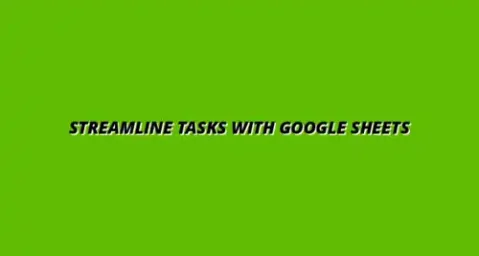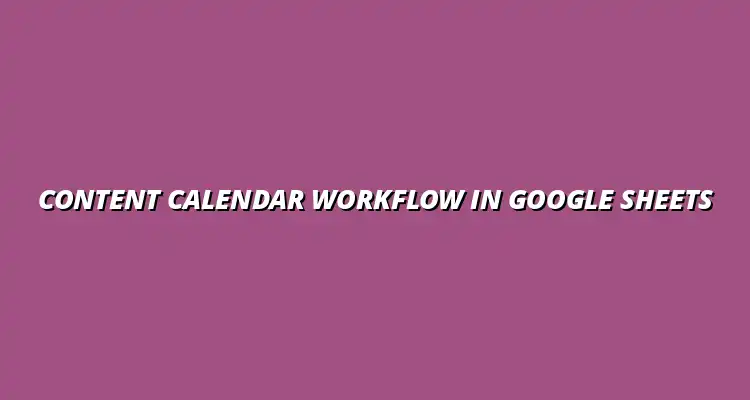
- Process Automation
- Dec 27
2025-01-18
Creating engaging and relevant content consistently is vital for any business's online success. That's where a content calendar comes into play! It serves as a roadmap, guiding your content marketing efforts and ensuring everything is organized and on track.
A content calendar allows you to plan your content in advance, giving you a clear view of what to publish, when, and where. It helps you align your content with important events, campaigns, and audience interests, ultimately enhancing your overall strategy. For example, a well-structured social media content calendar template can streamline your social media posting schedule.
In the fast-paced world of content marketing, having a content calendar is crucial. It allows you to manage multiple content pieces, avoid last-minute rushes, and maintain a consistent publishing schedule. This consistency helps build trust and engagement with your audience.
Moreover, a content calendar helps you identify gaps in your content strategy. By mapping out your content visually, you can easily spot where you might need to fill in topics or themes. This way, you can create a more comprehensive and engaging experience for your audience. Efficient content calendar management can significantly streamline data management and improve overall workflow.
One of the greatest benefits of using a content calendar is the ability to enhance consistency in your content marketing. By planning ahead, you can ensure that every piece of content aligns with your marketing goals and brand voice. This leads to a more cohesive and professional image.
With a calendar, you can easily plan themes and topics for each month or week. Here are some key points to consider when enhancing planning:
A content calendar is an excellent tool for fostering collaboration among your team members. It provides a centralized spot where all team members can see what content is planned and who is responsible for each piece. This transparency helps minimize confusion and overlaps. To track projects effectively, clear communication and organization are crucial.
When teams work together smoothly, they can create higher-quality content more efficiently. To promote better collaboration, consider these tips:
When it comes to managing your content calendar, Google Sheets stands out as an excellent choice. Its flexibility and ease of use make it accessible for everyone, whether you're a beginner or an experienced marketer. Plus, it’s free, which is always a bonus!
Using Google Sheets, you can create a customized calendar that suits your specific needs while leveraging its various features to enhance your workflow. The platform is designed to keep your content organized and efficient, allowing you to focus on what matters most: creating great content! Learn how to streamline your workflow with Google Sheets for better efficiency.
One of the main advantages of using Google Sheets is its cost-effectiveness. It’s free to use, which means you can save money while still getting powerful tools for your content calendar. This is especially beneficial for small businesses or startups that may be on a tight budget!
Furthermore, Google Sheets is accessible from anywhere with an internet connection, allowing you and your team to update the calendar on the go. Here are a few more reasons why it's a fantastic solution:
Another great feature of Google Sheets is its real-time collaboration capabilities. This means multiple team members can work on the content calendar simultaneously, making it easy to brainstorm and implement changes on the fly. It keeps everyone in the loop and promotes teamwork! Automating tasks can free up significant time; check out these Google Sheets automation tips.
To make the most of these collaboration features, remember to:
To make your content calendar truly effective, optimizing it is essential. This means leveraging tools like Google Sheets to enhance your workflow. Optimized calendars help you stay organized, track progress, and ensure your content reaches your audience on time.
Let’s dive into how you can *maximize the potential* of your Google Sheets content calendar for the best results. By utilizing its features effectively, you’ll streamline your content creation process and make collaboration much easier! You can even automate project management with Google Apps Script.
Google Sheets offers several functions that can significantly improve your content calendar's efficiency. Using these functions can help with organization and tracking, making it easier to keep everything in one place. Here are some helpful functions to consider:
Conditional formatting is a game changer for keeping your calendar organized. It visually cues you on tasks that need immediate attention. For instance, if a blog post is due soon, you can set it to highlight in red, prompting you to take action.
Here’s how to set it up:
Formulas can automate many tasks within your calendar. For example, you can set a formula to calculate how many days are left until a post is due. This helps you stay on top of deadlines without manual counting! Automating Google Sheets can drastically improve efficiency.
Some useful formulas include:
Collaboration is key when working with a team on content creation. Google Sheets allows multiple users to view and edit documents simultaneously. Here are some tips to enhance teamwork:
When sharing your Google Sheets content calendar, you need to manage permissions carefully. This ensures everyone has the right access to contribute effectively. Here are some best practices:
Effective communication can enhance your content calendar's success. Establishing clear channels for feedback ensures that everyone is on the same page.
As you work on your content calendar, you might have some questions. Below are some common inquiries that can help clarify your process:
Updating your content calendar is crucial for staying relevant. I recommend reviewing it at least once a week. This allows you to make adjustments based on performance and upcoming trends!
Absolutely! Google Sheets is versatile and can be tailored to track various marketing channels. You can create separate tabs for blogs, social media, email newsletters, and more!
Tracking metrics helps measure the success of your content. Some key metrics to include are:
It’s essential to emphasize the importance of flexibility in your content strategy. As trends change and new information arises, being adaptable allows you to stay ahead of the game. A rigid plan may limit your creativity!
Lastly, always look for ways to improve your content calendar workflow. Solicit feedback from your team and analyze what’s working and what’s not. Regular tweaks can lead to greater efficiency and better content overall!
